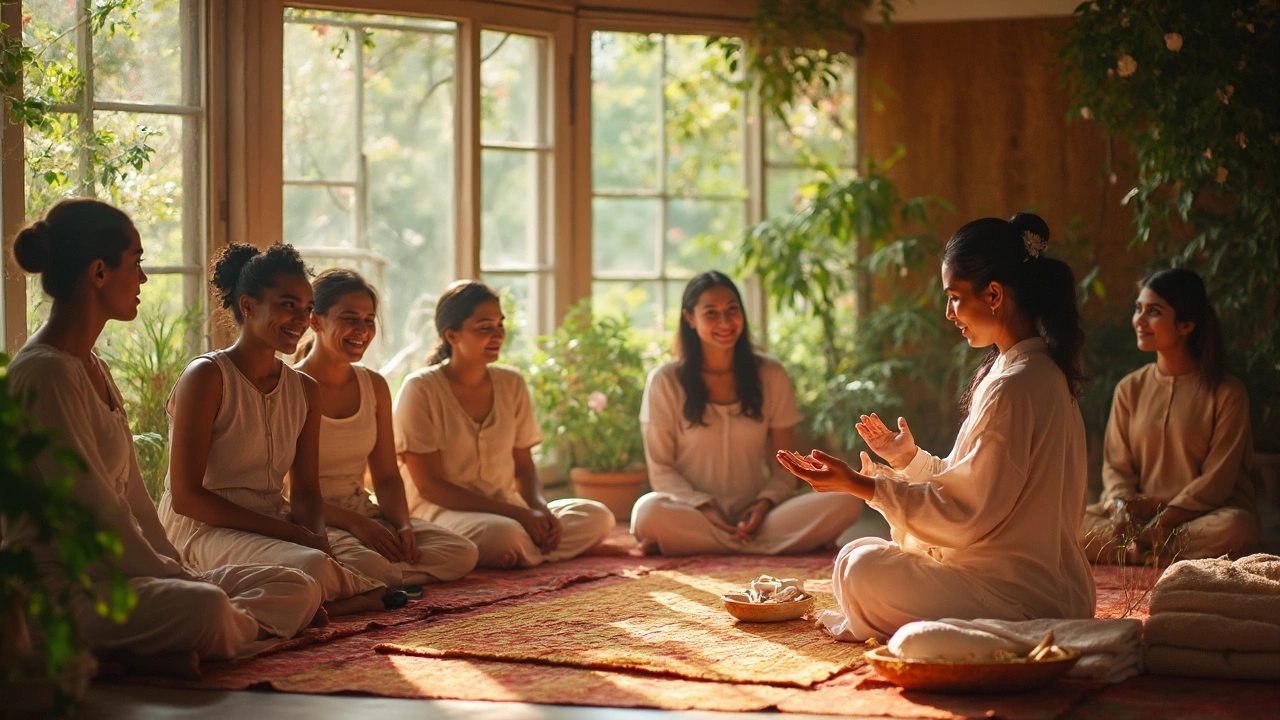Heard of 'hilot' before? It’s not your regular Swedish rubdown. This is the Filipino way of caring for both body aches and deeper imbalances—think of it as massage, but with a bit of detective work and even a touch of mystique. Hilot’s been around for centuries, passed down through families, and it’s survived simply because it works.
Ever had a stiff neck that just wouldn’t quit? Hilot isn’t just about kneading sore spots. Practitioners, called manghihilots, use their hands (sometimes banana leaves, coconut oil, or hot stones) to feel for blockages and tension. The idea is to put things back where they belong—muscles, joints, even your own sense of calm.
For many Filipinos, hilot isn’t some luxury spa thing. It’s home remedy, science, and tradition rolled into one. People book a session to help with headaches, back pain, or just to shake off stress from work. It’s not weird to see hilot done at home, local clinics, or even fancy hotels across the Philippines now.
Curious? Stick around. I’ll walk you through what sets hilot apart, what you should expect, and how to make the most out of your first session. You’ll probably start seeing why this old-school healing method is getting so much new-school attention.
- What Makes Hilot Unique?
- How a Hilot Session Works
- Tips for First-Timers
- Modern Uses and Ongoing Popularity
What Makes Hilot Unique?
Forget about cookie-cutter massages. Hilot stands out because it’s built on a homegrown system of touch, intuition, and tradition. What makes hilot different from popular massages like Thai or Swedish? It’s all about customizing every session—no two are alike. A manghihilot (the practitioner) literally listens to your body through their hands, searching for spots that feel “off,” not just sore.
Hilot’s roots go way back. Records show it was practiced long before Spanish colonizers arrived in the Philippines in the 1500s. Back then, it wasn’t just about muscle pain; it covered everything from high blood pressure to spiritual cleansing. According to a 2017 survey by the Department of Health in the Philippines, 52% of rural families had tried hilot for body pain or minor health complaints before visiting a clinic or pharmacy.
Unlike Western massages, hilot blends physical and spiritual care. The practitioner might use:
- Banana leaves—warmed and pressed on the skin to check for unevenness
- Coconut or herbal oils—massaged in to help loosen tight muscles
- Energy flow checking—done by sensing where heat or cold builds up
“Hilot adapts to the person, not just the problem. There’s no script, just knowledge passed down, body to body.”
– Dr. Jaime Galvez Tan, former Philippine Health Secretary
Many believe hilot can spot minor dislocations or imbalances that get missed in standard checkups. For example, a manghihilot may feel a tiny muscle knot or joint that’s just a bit out of place. Some practitioners swear by hilot’s knack for body reading—they’ll tell you where you’re stressed out just by the feel of your back.
| Technique Used | Purpose | Common Tools |
|---|---|---|
| Scanning with hands | Finds blockages/tension | Hands, banana leaves |
| Deep pressure massage | Releases knots | Thumbs, elbows, oils |
| Energy balancing | Restores energy flow | Body heat sensing |
This flexibility and personal touch keep hilot alive, especially as more people want treatments crafted for their own aches—not just a quick rub. For locals, it’s real-deal self-care, and for newbies, it’s a whole different way of reconnecting with your body.
How a Hilot Session Works
So, what actually happens during a hilot session? Picture this: you show up in comfy clothes, and usually, a manghihilot (that’s your hilot practitioner) will start by chatting with you about where you’re hurting or what feels off. There’s no one-size-fits-all. Each session gets tailored to your body. Most manghihilots rely on their hands and intuition, but they might pull out coconut oil, banana leaves, or even hot stones—depends on tradition and what you need.
The manghihilot then feels out your body, searching for blockages, tight muscles, and even temperature differences. Some of them can spot a knot or imbalance just by touch or by looking at how you stand. If they find something out of line, they’ll use special strokes, pressure, or stretches to bring things back to balance. It’s not just about muscle pain. Sometimes, they say your energy could be stuck and needs ‘unblocking’ too.
“You don’t just treat the pain; you look for the cause. Sometimes it’s the muscles, sometimes it’s the stress. Hilot is about listening and adjusting to fix the whole person, not just the sore spot,” explains Lorna Austria, a manghihilot in Quezon City, interviewed by Rappler in 2022.
Hilot isn’t supposed to hurt, but some deep pressure might be used, especially if you’ve got stubborn areas. Sessions generally last anywhere from 45 minutes to over an hour. Afterward, you might get a few tips from the manghihilot on home care—like how to stretch out certain muscles or avoid making the pain worse.
- Quick tip: If you’ve got allergies, let your practitioner know. Some natural oils and leaves can cause skin reactions for some people.
- It’s okay to ask questions—experienced manghihilots love explaining what they’re doing and why.
Some places offer modern hilot sessions that combine traditional moves with spa comforts, but at its core, the focus is still about fixing what’s out of whack, not just letting you zone out like a regular massage.

Tips for First-Timers
Jumping into a hilot session for the first time? You’re probably asking, “How do I make sure it’s awesome and not awkward?” Don’t worry, here’s what you need to know to get the best out of your experience.
- Be honest about pain and health issues. Your manghihilot will likely ask what hurts or if you have any old injuries. Don’t be shy here. Sharing even small details helps them figure out which techniques to use.
- Dress comfortably. Most sessions mean you strip down to your underwear or put on provided shorts. Unlike spa massages, hilot can be hands-on and may involve natural oils—so pick clothes that are easy to change out of and won’t get stained.
- Skip a heavy meal before. It’s a bad idea to go in stuffed. Give yourself at least an hour or two after eating, so you don’t feel bloated during the session.
- Stay hydrated but don’t overload on water. Drink some water before, but don’t guzzle right before starting. A big belly full of water can feel uncomfortable with some of the deeper work hilot involves.
- Expect the unexpected. Hilot can include banana leaves, warm coconut oil, or simple hand techniques. Every manghihilot has their own go-to moves, so don’t get thrown off if they do something unfamiliar—it’s normal.
- Speak up if anything hurts (the bad kind of pain). You might feel a good kind of pain as tight muscles release, but sharp or shooting pain isn’t okay. Let your practitioner know right away if something feels wrong.
Wondering how a typical session might go? Here’s a quick table breaking it down:
| Step | What Happens |
|---|---|
| 1. Chat/Assessment | Practitioner checks in about aches and health history |
| 2. Palpation | Manghihilot uses hands (and sometimes banana leaves) to feel for tension or imbalances |
| 3. Massage/Treatment | Targeted massage using hands, coconut oil, warm stones, or leaves |
| 4. Advice | Practitioner may give home tips or stretches for aftercare |
Most sessions last 45-90 minutes. If you’re sensitive to scents or have allergies (especially coconut), mention this up front. And for best results, try not to rush off right after—the most relaxed feeling usually hits once you’re home and settling in.
Modern Uses and Ongoing Popularity
Hilot isn’t stuck in the past. In fact, it’s getting a fresh wave of interest—not just in the Philippines, but all over the world. Places like wellness clinics, resorts, and even fitness centers are adding hilot to their services. People are after more than muscle relief; they want a full reset, and that’s what hilot claims to give.
The Department of Health in the Philippines now recognizes hilot practitioners and even sets training standards. Some cities offer free hilot sessions in community health centers, especially after disasters or for hard-working folks with no time for fancy shoes or spa days. Over 60% of adults in Philippines say they’ve tried hilot at least once, according to a survey by the University of the Philippines in 2023. That’s one of the highest rates for any kind of traditional healing in Asia.
Outside the country, hilot is popping up in Filipino communities in California, London, and the Middle East. Big hotels targeting tourists who want to try something "authentic" now put hilot on their spa menus. Celebrity chefs and travel bloggers love showing off their own sessions on YouTube or Instagram, giving it even more exposure.
If you’re thinking about trying this yourself, here are a few ways people now use hilot:
- Managing chronic back, neck, and headache pain
- Speeding up recovery from workouts or sports injuries
- Helping with stress, sleep problems, or plain old burnout
- Boosting general wellness (a lot of folks get monthly sessions as a preventative thing)
Still, it’s smart to check your practitioner's credentials—especially outside the Philippines, where anyone could claim to be a hilot expert. With its combination of hands-on care and tradition, hilot isn’t just a trend. The numbers back it up:
| Country | Hilot Centers Opened (2020-2024) | Reported Client Growth (%) |
|---|---|---|
| Philippines | 320 | 38% |
| USA | 55 | 47% |
| UK | 18 | 35% |
Don’t be surprised if you start hearing even more about hilot in the next few years. The world’s finally catching on to what Filipinos knew all along—sometimes, all you need is the right touch.

